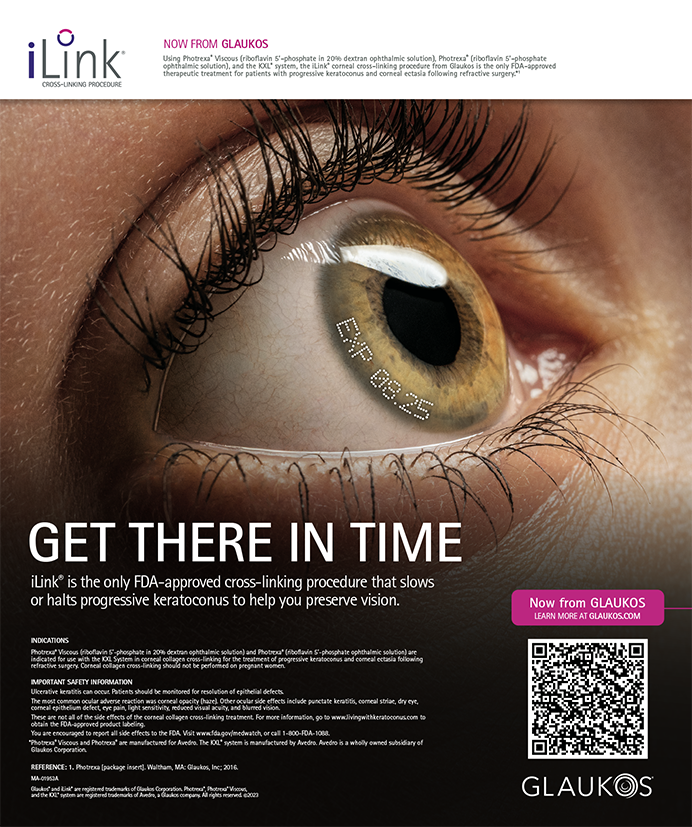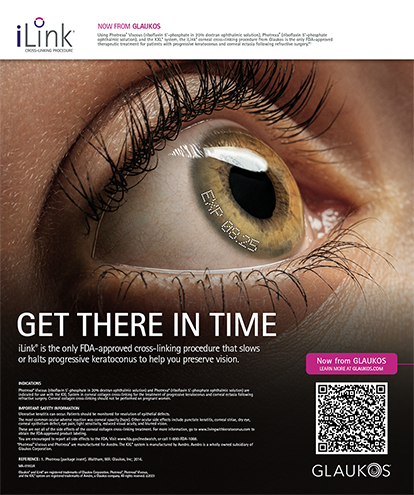Optical coherence tomography (OCT) is rapidly becoming a must-have technology for all ophthalmic practices, not just those that focus on retinal pathology. OCT scans have progressed from fuzzy, grainy images of the macula to images that yield nearly histologic-quality depictions of ocular structures. With the development of the Fourier-domain OCT, which uses a faster scanning rate than older time-domain OCT systems, ocular tissue can be examined like never before. In addition to better images of the macula, clinicians can use OCT technology to help them manage glaucoma and view the cornea. The RTVue OCT (Optovue Inc., Fremont, CA) allows opthalmologists to enhance their care of patients. This device has an axial resolution of approximately 5 µm and a scanning speed of 26,000 A-scans per second, which provides better resolution than is available with other OCT instruments.1
HOW OCT OBTAINS IMAGES
OCT is a noncontact technology that obtains images by measuring the time delay of reflected near-infrared light. Each individual axial reflection is combined over a transverse dimension to yield the image of structures such as the cornea (Figure 1). Similarly, clinicians can obtain information about the optic nerve head and ganglion cells when evaluating glaucoma or the macula when assessing macular disease.
GLAUCOMA EVALUATION AND MANAGEMENT
Perhaps the most valuable use of the RTVue OCT in a nonretinal practice is for the management of glaucoma, which entails a combination of clinical evaluations and objective tests that allow physicians to follow the health of the optic nerve. Practitioners’ clinical evaluation of the optic nerve is ultimately limited by what they can view with the slit lamp. One determines the optic nerve’s health by following trends such as optic nerve cupping, standard automated perimetry or visual fields, IOP, and corneal thickness. Clinicians can monitor optic nerve head cupping through drawings, but there can be drastic variability from observer to observer.2 Optic nerve head photographs are useful but can be limited in their ability to pick up subtle details. Glaucoma patients are typically older and are not always able to accurately perform the current gold standard visual field test. It can be extremely frustrating for physicians to make long-term clinical decisions regarding glaucoma management with visual field data that have large numbers of fixation losses and false positive and negative errors. Eye care professionals then base their target IOP on potentially limited clinical findings of optic nerve health and visual fields.
With OCT, practitioners can quickly and accurately measure the thickness of the optic nerve head at all points circumferentially and the peripapillary retinal nerve fiber layer (RNFL). These measurements are independent of the patient’s ability to press a button when he or she sees a dim light, as is required with standard automated perimetry testing. Thus, the sensitivity and specificity are unrelated to a patient’s ability to perform the test. This more standardized way to document the health of the optic nerve aids clinicians in choosing a target IOP. OCT is also less affected by cataracts than standard automated perimetry visual field testing.
Reduced macular thickness in glaucoma has been reported by Ziemer et al.3 Measuring the inner RNFL, ganglion cell layer, and inner plexiform layer (referred to as the ganglion cell complex [GCC]), has been shown to increase diagnostic accuracy for glaucoma.4,5 RNFL measurements combined with changes in the optic nerve head thickness provide more data that allow us to better follow glaucoma progression. 6,7sup> OCT can provide information about changes in the health of the optic nerve and the GCC earlier than clinicians can detect them with the slit lamp. Changes in the RNFL and optic nerve head’s thickness may precede visual field loss. OCT can detect changes in the RNFL and optic nerve head’s thickness earlier, ultimately helping clinicians to slow or arrest visual field loss and provide better glaucoma management (Figure 2).
ANTERIOR SEGMENT AND CORNEAL IMAGING, KERATOCONUS DETECTION
Anterior segment and corneal imaging have obvious uses in evaluating corneal opacities, LASIK flaps, and Descemet’s stripping endothelial keratoplasty buttons as well as for measuring the anterior chamber angle. Lesserknown uses for OCT include the evaluation of corneas for keratoconus and the determination of true corneal power to aid in post-LASIK IOL calculations.
OCT can be used to detect abnormal corneal thinning in keratoconus.8 David Huang, MD, PhD and his colleagues have derived OCT corneal thickness parameters that are predictive of the cornal ectasia seen in keratoconus. Evaluations can be performed by comparing thickness relationships between the superonasal octant and the inferotemporal octant, superior and inferior octants, and thinnest corneal thickness as well as the magnitude of the differences in corneal thickness. Using these diagnostic parameters and cutoff values, the results of the corneal scan can be used to determine the likelihood of keratoconus.
In Figure 3, the superior-nasal octant thickness minus the inferotemporal octant thickness value of 78 µm is greater than the cutoff of 45 µm, which would not necessarily point to keratoconus. However, the superior octant thickness minus the inferior octant thickness value of -26 µm is much less than 45 µm, the minimum thickness value of 414 µm is less than the cutoff value of 470 µm, and the minimum corneal thickness minus the maximum corneal thickness value of -157 µm is less than the cutoff value of -100 µm. This cornea is abnormal in three of the four parameters, which is highly suggestive of keratoconus.
One problem facing ophthalmologists is calculating IOL powers after LASIK. The true corneal power can be calculated using OCT to measure corneal pachymetry and curvature. This is a promising technique that is currently being studied.
CONCLUSION
OCT greatly helps anterior segment surgeons and general ophthalmologists. With straightforward training of technicians, the OCT scans can be obtained quickly and with great accuracy. Having digitized, repeatable optic nerve parameters along with a traditional clinical diagnosis helps physicians to determine glaucomatous progression. When the patient cannot perform standard visual field testing, the OCT is invaluable. Having the ability to image the cornea with OCT provides one more technique by which to diagnose and manage corneal disease. OCT has always been a great way to image the macula. The technology allows clinicians to evaluate patients quickly and easily for retinal thickening related to an epiretinal membrane, central serous retinopathy, cystoid macular edema, or diabetes, to name a few. OCT has many other uses beyond imaging of the macula!
Robert Brass, MD, is an associate clinical professor of ophthalmology at Albany Medical College, and he is in private practice at Brass Eye Center in Albany, New York. He is a speaker for and is involved in clinical research with Optovue, Inc., but he acknowledged no other financial interest in the company or its products. Dr. Brass may be reached at (518) 782-7827; drbrass@drbrassonline.com.
- Kiernan DF,Mieler WF,Hariprasad SM.Spectral-domain optical coherence tomography:a comparison of modern high resolution retinal imaging systems.Am J Opthalmol. 2010;149:18-31.
- Cox ML,Wood IC.Inter-observer variability in a computer-assisted optic nerve head assessment system.Ophthalmic Physiol Opt. 1992;12:69-71.
- Zeimer R,Asrani S,Zou S,et al.Quantitative detection of glaucomatous damage at the posterior pole by retinal thickness mapping:a pilot study.Ophthalmology.1998;105:224-231.
- Ishikawa H,Stein DM,Wollstein G,et al.Macular segmentation with optical coherence tomography.Invest Ophthamol Vis Sci. 2005;46:2012-2017.
- Tan O,Li G,Lu AT,et al.Mapping of macular substructures with optical coherence tomography for glaucoma diagnosis. Ophthalmology.2008;115:949-56.
- Garas A,Vargha P,Holló G.Reproducibility of retinal nerve fiber layer and macular thickness measurement with the RTVue- 100 optical coherence tomograph [published online ahead of print January 14,2010].Ophthalmology.doi:10.1016/j.ophtha. 2009.08.039.
- Li G,Fansi AK,Boivin JF,et al.Screening for glaucoma in high risk populations using optical coherence tomography. Ophthalmology.2010;117(3)453-461.
- Li Y,Meisler DM,Tang M,et al.Keratoconus diagnosis with optical coherence tomography pachymetry mapping. Ophthalmology.2008;115 2159-2166.


